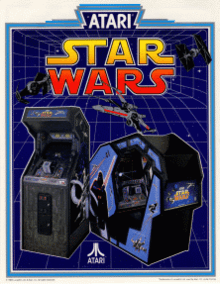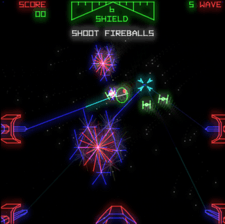Star Wars (1983 video game)
| Star Wars | |
|---|---|
 North American arcade flyer showing the standup and sitdown versions of the game | |
| Developer(s) | Atari, Inc. |
| Publisher(s) | Atari, Inc. |
| Designer(s) | Mike Hally |
| Platform(s) | Arcade |
| Release date(s) | |
| Genre(s) | Rail shooter |
| Mode(s) | Single player |
| Cabinet | Upright and sit-down cockpit |
| Display | Vector horizontal |
Star Wars is an arcade game produced by Atari Inc. and released in 1983.[2] The game is a first person space combat game, simulating the attack on the Death Star from the 1977 film Star Wars. The game is composed of 3D color vector graphics. This game was developed during the Golden Age of Arcade Games and is considered the #4 most popular game of all time according to the readers of Killer List of Videogames.[3]
Gameplay

The player assumes the role of Luke Skywalker ("Red Five"), as he pilots an X-wing fighter from a first-person perspective. Unlike other arcade games of similar nature, the player does not have to destroy every enemy in order to advance through the game; he must simply survive as his fighter flies through the level, which most often means he must avoid or destroy the shots that enemies fire. Each hit on his craft takes away one shield (of the six he started out with), and if he runs out of shields and takes another hit, the game ends.
The player's ultimate goal is to destroy the Death Star through three attack phases.
- In the first phase of the game, the player begins in outer space above the Death Star. The player must engage in a dog fight with Darth Vader and enemy TIE fighters.
- In the second phase, the player reaches the Death Star's surface as laser turrets on towers rise to confront the player. The player is awarded a bonus for destroying a certain number of turrets.
- In the final scenario, the player must navigate the trench of the Death Star, avoiding obstacles and gun turrets until finally firing a proton torpedo at the correct time for a direct hit on the exhaust port target. If the player is successful, the Death Star explodes and the player is awarded a bonus shield up to a maximum of 6. Should the player fail to hit the exhaust port, a shield is lost and the player must attempt the trench again. If the player manages to destroy the Death Star without firing at anything but the exhaust port, a bonus is awarded for "using the Force."
The game then resets to the first phase. Each successive Death Star run greatly increases the difficulty; TIE Fighters shoot more often, there are more Laser towers and batteries in the second round, and there are many more obstacles and laser fire during the trench run. Unlike the movie, where the units shoot beams similar to lasers, the enemy units in this game shoot projectiles resembling fireballs, in order to give the player a chance to destroy the fired shots.[2]
Arcade details
The game features several digitized samples of voices from the movie, including Mark Hamill as Luke Skywalker, Alec Guinness as Obi-Wan Kenobi, James Earl Jones as Darth Vader, Harrison Ford as Han Solo, the mechanized beeps of R2-D2, and the growls of Chewbacca. The game is available as a standard upright or a sit-down cockpit version, both of which are elaborately decorated. The controls consist of a yoke control with four buttons — two trigger style and two in position to be pressed by the thumbs — each of which fired a laser positioned on the four leading edges of the X-Wings.
After the TIE fighter waves, when flying towards the Death Star, the yellow grid lines on the Death Star spell out either "MAY THE FORCE BE WITH YOU" on odd-numbered waves or names of some of the developers on even numbered waves.
This game can be converted into The Empire Strikes Back via a conversion kit.[2]
Records
In 1984 Robert Mruczek scored 300 million points in 49 hours of gameplay (the world record for an individual) and in 2005, Brandon Erickson set a world endurance record of 54 hours on a single credit (with a score of 283 million).[4] In June 1985 Flavio Tozzi, Dave Roberts and Mike Ohren played as a team in turns for five days, two hours and 26 minutes on a single credit to attain the world record score of 1,000,000,012 points. It was featured on Yorkshire Television and was verified in the September 1985 edition of the UK Computer and Video Games magazine. Their efforts raised money for a local charity.[5] The score counter of this game "turns over" at 100 million points.
Because of the fact that a number of skilled players could play indefinitely on the factory settings, it was decided to put the machines on a harder setting for the annual Twin Galaxies International Scoreboard/Guinness Book Masters Tournament, where the player would have six initial shields but NO bonus shields, and thus the game would be a test of skill rather than endurance. In the 1986 Tournament, David Palmer scored 31,660,614 points on that setting (in approx. 7 hours), a score which was subsequently published in the Guinness Book of World Records and which remains the world record to this day.[6]
Home versions
The game was originally designed for the arcade by Mike Hally.[7] It was converted first by Parker Brothers in 1983 and 1984 to numerous 8-bit consoles and computers. These include the Atari 2600, Atari 5200, the Atari 8-bit family, ColecoVision and Commodore 64. The home console version for the ColecoVision was designed by Wendell Brown.[8] The Atari 5200 version is infamous for its commercial, in which a guy overreacts while playing the game, telling the cashier at the video game store he's in that it was "some game!".

The same game was converted again, in 1987 and 1988, for the Amiga, Atari ST, Amstrad CPC, ZX Spectrum, Acorn Electron, BBC Micro and Enterprise 64; the game was also converted again for the Atari 8-bits and the Commodore 64. All conversions were developed by UK-based Vektor Grafix (the Atari 8-bit version by Zeppelin Games being an exception) and were published in Europe by Domark. That same year Brøderbund acquired the rights to develop Star Wars games from Lucasfilm. Brøderbund published the Apple II, Apple Macintosh, Commodore 64 and DOS versions of the arcade game in North America in 1988.
The Amiga and Atari ST versions are very similar to the arcade original. They allow the ability to use mouse control and feature digitized sound effects. The Macintosh version contains sampled speech from the films, but has no in-game music other than a monophonic theme during the "attract" mode.
This game, along with The Empire Strikes Back and Return of the Jedi, was also included as an unlockable extra in the Nintendo GameCube game Star Wars Rogue Squadron III: Rebel Strike. In the United States and some European countries, customers could get the GameCube version of the game for free when they pre-ordered Rebel Strike.
Reception
Compute! praised the Atari ST version of Star Wars, calling it "amazing, smoothly animated".[9] The DOS, Amiga, Atari ST, and Commodore 64 versions by Broderbund Software were reviewed in 1989 in Dragon #145 by Hartley, Patricia, and Kirk Lesser in "The Role of Computers" column. The reviewers gave the game 3 out of 5 stars.[10]
References
- ↑ http://www.arcade-history.com/?n=star-wars-upright-model&page=detail&id=2623
- 1 2 3 "Star Wars - Atari (1983)". The International Arcade Museum. Retrieved 2014-06-24.
- ↑ "The Top Coin-Operated Videogames of all Times". The International Arcade Museum. Retrieved 2014-06-25.
- ↑ "Yale Alumni Magazine: Arts & Culture". Archived from the original on 2006-08-23.
- ↑ "Alien Bashing Record" (47). Computer and Video Games. September 1985: 119.
- ↑ "1987 Guinness Book of World Records".
- ↑ "Star Wars". arcade-history.com. Retrieved 2014-06-26.
- ↑ "Star Wars". colecovision.dk. Retrieved 2014-06-26.
- ↑ Plotkin, David (July 1988). "ST Star Wars". Compute!. p. 51. Retrieved 10 November 2013.
- ↑ Lesser, Hartley; Lesser, Patricia; Lesser, Kirk (May 1989). "The Role of Computers". Dragon (145): 44–53.
External links
- Star Wars at the Killer List of Videogames
- Star Wars at the Arcade History database
- Star Wars at MobyGames